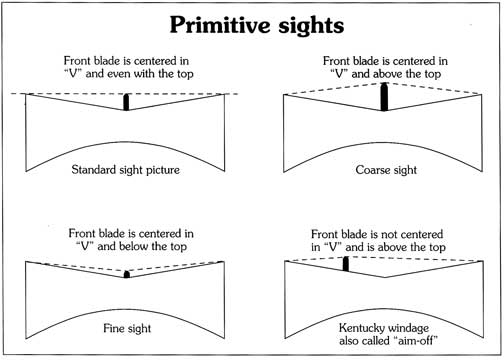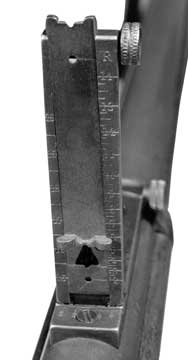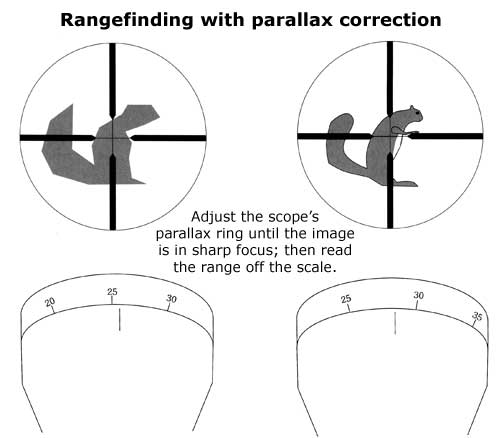by Tom Gaylord
Copyright PyramydAir.com ©2009. All Rights Reserved.
This article originally appeared in Airgun Revue #2, published in 1998.
Related articles:
Accuracy--it's not a given! Part 1: The barrel
Accuracy--it's not a given! Part 2: The projectile
Sights are an important component of an airgun's accuracy, and there has been a revolution in sighting over the last 20-30 years. Before the 1970s, optical sights on an airgun were rare, just as they were for firearms 10 years earlier. People just didn't trust optics back then, in much the same way new airgunners feel there must be some inherent inaccuracy in breakbarrel rifles today (there isn't). So, let's look at iron sights first and finish with optics.
Iron sights evolved like the other parts of a gun's mechanism--when they were needed. In the 17th century, there wasn't much call for precise sighting devices because the guns of that period were only capable of mediocre accuracy. Hitting a man at 100 yards was presumed to be luck with military long guns, and only a few highly crafted sporting weapons were any better. Crossbows were better for light hunting, and there were even special-purpose crossbows that shot round stones at birds and small game, such as rabbits.
Rifling did not come into general use until the 1700s, and even then it took some time to be widely accepted. So, it's only natural that airguns followed firearms in the types of sights they used, because they were generally as inaccurate and range-limited. You only have to look at the Girandoni windbuchse of 1780--a repeating rifle capable of hitting and killing a man at 100 yards--to see that sights were not keeping pace with the capabilities of the time. Even the sporting version of this rifle, made by Joseph Schembor, had only a front sight.
But rifled barrels did eventually prevail, so sights had to evolve to extract the extra accuracy available. The first sights were crude by today's standards, but they worked well and can still work well if a shooter takes the time to learn them. A blade on the front of the barrel was centered in a rear leaf that had a shallow "V" notch. Elevation was determined by how much of the front blade could be seen above the rear notch. A coarse sight was one in which the front sight stood high above the rear; a fine sight was one where it only barely showed. As the shooter became familiar with the gun, he would be able to discriminate slight variations in between.

By holding the front blade to the right or left of the center of the rear "V," variations left or right--or windage, as it has come to be known--could be applied. I've owned certain rifles that were so repeatable that I gained a sense of where to aim to hit the target. If a person shoots just one rifle all the time, this sense develops fully, allowing some very accurate shooting that could almost be termed instinctive. The phrase, "Beware of the man with one gun," came from such an association.
Of course, all this talk about instinctive sighting requires a faithful dedication to just one single load. That means one bullet from one mold; one load of powder; the same powder all the time; and even the same percussion caps, when they came into the picture. Change any part, and the whole thing has to be recomputed and relearned.
The next innovation in sighting--aperture sights--came at a time I haven't been able to establish very accurately. And they didn't come all at once, either. The rear aperture, which I believe is the most important part of the discovery, evolved separately from the front, which actually took longer and is still changing today.
Aperture sights existed before the US Civil War (1861 to 1865). German muzzleloading schutzens had them many years earlier. According to the literature I have examined, they were in use as early as 1840 on muzzleloading Schutzens. Those sights were already well developed, though, so there must have been an even earlier gestation period. I believe this is one of those things that probably bumped along for many years before coming into general use.
The aperture sight is the easiest to use of all iron sights (a term that means sights without optical assists, such as lenses). That's because the shooter has only to look at the front sight and the target--one less element than the simpler-looking open sights, described above. And, this feature is the very thing that keeps most people from using them, because they don't understand how these sights work. (There ARE aperture sights with magnifying lenses and even prescription-ground corrective lenses, but they will not be addressed in this article.)
Aperture sights are also commonly called peep sights in the US, because the shooter must peep through the small aperture in the rear to see the front sight. Like a camera lens, the human eye becomes much more capable of precise focus over a broad range of distance (depth of field) when the light admitted is restricted by a small hole.
To use aperture sights to their fullest, the target should be well-lit and the shooter should be in relative darkness. Aperture shades and eye patches for the other eye help create this situation.
Sporting apertures also exist, but they're much larger than target apertures for rapid target acquisition. The M1 Garand even went into battle with a peep sight, and many thousands of servicemen learned just how good these sights can be. Of course, we should not forget that their grandfathers once learned the same lesson with the famous Buffington rear sight of the Trapdoor Springfield.

The Buffington sight brought the aperture from target shooting to combat. It dates to 1884.
A special variant of the aperture sight is the tube sight, which looks like a telescopic sight on the outside. Inside the long tube, though, there are no lenses--just a front and rear element. The tube helps align the elements and, of course, reduces light for a sharper picture.
The most common sights in use on airguns today are the telescopic sights. There was a dramatic revolution and change of opinion concerning scopes in the 1960s. Before that time, they were regarded as somewhat less than sporting and even prone to failure at the most inappropriate times in the field. This was partly due, no doubt, to the fact that no rifles were made for easy scope mounting. Receivers had to be spot-annealed, after which holes for the mounts had to be drilled and tapped--hopefully level with the top of the receiver.
Scope manufacturers battled this prejudice for years before tipping the balance their way; but, in the end, they won almost completely. Gunmakers now customarily prepare their rifles, and even some pistols, to take scope mounts with little fuss. Companies like B-Square have made a business out of supplying no-gunsmithing mounts for the others. Today, it's the rare shooter who goes afield with iron sights. Even the muzzleloading crowd is starting to put scopes on their guns, and shotgunners are more than halfway converted--at least among the slug gunners.
The telescopic sight presents a single sighting plane to the shooter--the easiest of all the sight pictures to work with. Also, the additional factor of magnification is a treat, allowing farther shots with greater precision. Noted blackpowder writer Sam Fadala estimates that putting a scope on a gun increases the average shooter's realized accuracy by a factor of two.
Of course, with scopes comes the special problems of mounting, parallax, alignment with the barrel, and, at least with recoiling airguns, breakage. Most people are now aware that an airgun is harder on a scope than a firearm, by virtue of its two-way recoil pattern. Scopes have long been braced against recoil to the rear, but few were ready for the strong forward thrust of an air rifle. Some companies now make special airgun scopes that are correctly braced, while others like Leupold, simply brace all their scopes against all jarring movements and make no special distinctions about application.
Parallax, or adjustment for the range at which the scope is used, is another airgun quirk. On scopes designed for centerfire guns, the parallax may be fixed at some distance that averages out to the probable range at which the gun will be fired--say 100 to 150 yards for centerfires and 50 yards for rimfires. At greater or lesser ranges, the parallax is off--but the effect is so small that no one really cares.
Better scopes have parallax adjustments, but they usually adjust only as close as 50 yards. For an airgunner, 50 yards is generally the far limit at which shots will be taken, or very close to it. So, their scopes must be adjustable down to a much closer range. Ten yards, and even 7-1/2 yards, is common among the airgun-specific scopes having a parallax adjustment.

The telescopic sight is responsible for more interest and confusion among new airgunners than any other single item of equipment. It is very disconcerting to watch a group open up to one inch in front of your eyes. The fact that you're shooting at a target 40 yards away, where an inch may be the best you can expect, is seldom taken into account. The small holes left by a .177 pellet give the visual impression that you're shooting all over the place. It's similar to watching a 22/250 print a 2-1/2" group at 100 yards--not a pretty sight!
Compounding this problem, the airgunner is typically watching his group take shape through an 18-40x magnification that renders the image of the target as large as a barn door! This is the frustration, I believe, that often leads some people to pursue a fanatical assault on ultimate accuracy in which thousands of dollars will be spent on all possible improvements to a gun.
Another help a scope gives airgunners is rangefinding through parallax correction. Similar to the coincidence rangefinder of a camera, in which two images converge into one at a certain predetermined range, on some powerful scopes, the parallax adjustment is precise enough to determine the range to the target to within one meter. The shooter simply adjusts the parallax while watching the target through the optics. When it comes into sharp focus, the scope is corrected for that range, which may then be read off the range scale on the adjustment knob or ring. It takes about 24x or more to make very precise estimates, although 18x will usually get you within five yards of the true range. Knowing the range helps, because the air rifle pellet has a very pronounced trajectory at close range. When you're trying to shoot through a hole one inch in diameter, having a two-inch variation in trajectory makes the shot a crap shoot.
To use a scope successfully, an airgunner has to take the time to learn a bit about the technology before charging out into the woods to win field target matches. For instance, a popular misconception among new airgunners is that airguns having fixed barrels are more accurate than breakbarrel guns, and that those fixed barrels will (or should) be pointed in the same direction as the scope rails. That isn't true for firearms, so why should it be different for airguns? Firearm shooters who use scopes have known for decades that very few rifles leave the factory with their barrels pointed in the same direction as bases for their scope mounts. Shimming has long been an accepted cure for this. While it's true that modern manufacturing methods, such as investment casting, have improved this situation greatly, we still don't expect to just slap on a scope and hit the bricks.
Yet, that's exactly what some airgunners expect. They want the manufacturer to press that barrel into that bushing, and then the bushing into the receiver tube (which can have no variance in wall thickness, by the way) with zero deviation in relation to the machined grooves on the scope rail. And, of course the scope mount maker attended the same meeting and agreed to the precise final dimensions of the rails and the receiver tube diameter--along with every airgun maker on the planet! And, don't forget the barrel maker--a different company in almost all instances. They have somehow learned how to drill a straight hole through the exact center of a steel bar. If you think about all the variables, it's a wonder that a scope ever works!
So, there's a lot to learn if you're going to use a scope on an airgun. But scoping your gun is still the way to wring out the most potential accuracy, so the time spent in study is well worth the investment.
Open sights, apertures, and scopes--there's a lot to learn about airgun sighting equipment. And, we haven't even touched on the exotic stuff, like dot sights and lasers. Just remember that your sights are what help you align your barrel with the intended target. Choose wisely!
Buy With Confidence
Get FREE shipping on qualifying orders! Any order $150+ with a shipping address in the contiguous US will receive the option for free ground shipping on items sold & shipped by Pyramyd AIR during checkout. Certain restrictions apply.
Free shipping may not be combined with a coupon unless stated otherwise.
View Shipping Info
We work hard to get all orders placed by 12 pm EST out the door within 24 hours on weekdays
because we know how excited you are to receive your order.
Weekends and holiday shipping times will vary.
During busy holidays, we step our efforts to ship all orders as fast as possible,
but you may experience an additional 1-2 day delay before your order ships.
This may also happen if you change your order during processing.
View Shipping Times
It's important to know that due to state and local laws, there are certain restrictions for various products.
It's up to you to research and comply with the laws in your state, county, and city.
If you live in a state or city where air guns are treated as firearms you may be able to take advantage of our FFL special program.
U.S. federal law requires that all airsoft guns are sold with a 1/4-inch blaze orange muzzle
or an orange flash hider to avoid the guns being mistaken for firearms.
View Shipping Restrictions
Get the most out of your equipment when you work with the expert technicians at Pyramyd AIR. With over 25 years of combined experience, we offer a range of comprehensive in-house services tailored to kickstart your next adventure.
If you're picking up a new air gun, our team can test and tune the equipment before it leaves the warehouse. We can even set up an optic or other equipment so you can get out shooting without the hassle. For bowhunters, our certified master bow technicians provide services such as assembly, optics zeroing, and full equipment setup, which can maximize the potential of your purchase.
By leveraging our expertise and precision, we ensure that your equipment is finely tuned to meet your specific needs and get you ready for your outdoor pursuits. So look out for our services when shopping for something new, and let our experts help you get the most from your outdoor adventures.
View Service Info
Shop and purchase with confidence knowing that all of our products (except airsoft) are protected
by a minimum 1-year manufacturer's warranty from the date of purchase unless otherwise noted on the product page.
A warranty is provided by each manufacturer to ensure that your product is free of defect in both materials and workmanship.
View Warranty Details
Didn't get what you wanted or have a problem? We understand that sometimes things aren't right and our team is serious about resolving these issues quickly. We can often help you fix small to medium issues over the phone or email.
If you need to return an item please read our return policy.
Learn About Returns
Get FREE shipping on qualifying orders! Any order $150+ with a shipping address in the contiguous US will receive the option for free ground shipping on items sold & shipped by Pyramyd AIR during checkout. Certain restrictions apply.
Free shipping may not be combined with a coupon unless stated otherwise.
View Shipping Info
Want More?
Join Our Email List for News and Deals!
Join the Pyramyd AIR mailing list: Our e-mails are filled with new products, deals, sneak peeks, tips and tricks, contests and more - sign up today!
Text JOIN to 91256 and get $10 OFF Your Next $50+ Order!
* By providing your number above, you agree to receive recurring autodialed marketing text msgs (e.g. cart reminders) to the mobile number used at opt-in from Pyramyd AIR on 91256. Reply with birthday MM/DD/YYYY to verify legal age of 21+ in order to receive texts. Consent is not a condition of purchase. Msg frequency may vary. Msg & data rates may apply. Reply HELP for help and STOP to cancel. See Terms and Conditions & Privacy Policy.